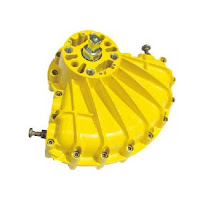 |
| Water treatment plant |
Sewage sludge is the semi-solid material that is produced during sewage treatment of industrial or municipal wastewater. Sludge blowdown valves are used in water and wastewater treatment systems that separate solids prior to filtration. These valves are particularly susceptible to fouling and ultimately prone to failure.
Many valve manufacturers specify high-pressure/high-torque actuators to overcome the sludge. Many times they choose linear type valves and screw-type linear actuators because they provide the brute force needed to push through the sludge. An unwanted side-effect of using linear valves and actuators is that the same force used to push the disc through the sludge, also causes valve damage by pushing and grinding solids into the valve seats, disc and seals. Eventually, the valve becomes so damaged it no longer provides proper shut-off.
 |
| Kinetrol actuator |
Pneumatic scotch yoke and rack and pinion actuators, with quarter-turn valves, can provide the torque required for opening and closing the valve, and the nature of some quarter-turn valve designs protect internal parts from damage. Plug valves are designed this way and when combined with double acting pneumatic actuators that operate on a controlled time frequency, are a very reliable design for this application. The cycle frequency depends on the amount of solids in the media, and cycle times of opening and closing every 20 minutes are common. This cycle rate however, is problematic for scotch yoke and rack and pinion actuators, causing them to fail prematurely. In some cases the actuators fail in only 3 - 4 months of use.
For sludge applications, Kinetrol rotary vane actuators mounted on quarter-turn plug valves are a great choice . The combination of the high cycle actuator design, with the design benefits of a plug valve, offer wastewater treatment operators a valve assembly that will provide years of trouble-free life.

